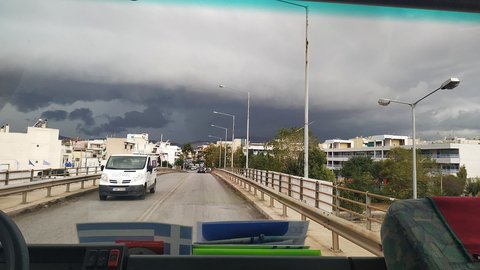
I do not have a great deal of formal training but I do have 13 years of storm chasing experience. Not to mention the fact that the storm was tornado warned. Those things seemed to gel with what I was seeing on radar. There was a notch in the line (inflow) and a lowering which showed some very weak rotation. That in itself makes a shelf cloud impossible. The line of storms were still inflow dominant at the time. Observing the storm myself it was clear that this reporter either needed more experience or more than likely enjoys drama! My call was simple. I actually witnessed a local news person nearly fear mongering at a gas station in Sedan, telling the employees and doing a phoner explaining how he witnessed multiple funnels headed towards town.

First of all I do agree with you that there are more than enough faulty reports such as SLCs as funnels or shelf clouds as wall clouds. Looking southwest at a lowering exhibiting classic shelf structure: Curtain like appearance, pointing away from the precip core:īeing one of only a few persons that reported a wall cloud yesterday I feel the need to explain my call. We had what looked like a completely occluded base, and so were in the process of bailing, but the north end reorganized and we had a cone tornado minutes later: Your strongest tornadoes form here, while the old wall cloud fans out well to the south. In a cyclical supercell, the north end of that bowed out wall cloud is going to reorganize, tighten into a new wall cloud, and the whole process repeats. Your typical shelf clouds are usually formed by forward flanking downdrafts in multicell clusters and squall lines. At this point I would say the feature actually is a shelf cloud as the RFD is dominant. This is what happens when an updraft becomes occluded. It often continues to do so until the original wall cloud has fanned out into what looks like a regular shelf cloud. When a clear slot forms in a wall cloud, the rear flanking downdraft is in the process of punching through.

So, I'd think that most anything on the leading edge of a big storm is rarely going to be properly called a wall cloud. Wall clouds should be monitored visually for signs of persistent, sustained rotation and/or rapid vertical motion. Rotating wall clouds usually develop before strong or violent tornadoes, by anywhere from a few minutes up to nearly an hour. When seen from within several miles, many wall clouds exhibit rapid upward motion and cyclonic rotation. Wall clouds can range from a fraction of a mile up to nearly five miles in diameter, and normally are found on the south or southwest (inflow) side of the thunderstorm. *Wall Cloud - A localized, persistent, often abrupt lowering from a rain-free base. The glossary page for storm spotters (Norman) gives this definition for wall cloud: Wikipedia is a nice way to get a basic intro to a subject, or links to more definitive sources - but I wouldn't use them as my primary source. If you see a shelf cloud, it’s best to briefly enjoy the view while the cloud is still in the distance and find shelter before it gets too close.I'll let others with more experience answer, but I'll just put in my 2 cents. Image: A dark and distant shelf cloud above the Gold Coast on November 28, 2022.

These storms may also bring heavy rain and large hail. While shelf clouds don’t usually won’t cause severe weather themselves, those associated with severe thunderstorms or squall lines can come with damaging straight-line winds. Shelf clouds produced by thunderstorms are always preceded by a rush of dry and cold air ahead of the cloud, with rain arriving after the shelf cloud has passed overhead. Image: A ragged shelf cloud producing showers over the Sydney on November 27, 2022. This rush of cold air often occurs in a thunderstorm’s downdraught, where cold air rushes towards the ground before spreading out to create a gust front. Shelf clouds form when cold and dense air is forced into a warmer air mass by wind.

Image: A large shelf cloud sweeping over the Gold Coast in southeast Qld on November 28, 2022. Technically called arcus clouds, shelf clouds usually appear as a broad arc across the sky that can sometimes appear to be rotating horizontally. Image: Shelf cloud passing over the Sunshine Coast on November 27, 2022. Shelf clouds are, as the name suggests, large shelf-like clouds that usually form at the leading edge of a thunderstorm or along the boundary of a cold front. But what exactly is a shelf cloud, how do they form, and just how dangerous are they? Thunderstorms in Australia often produce mesmerising shelf clouds.


 0 kommentar(er)
0 kommentar(er)
